PA3-022
antibody from Invitrogen Antibodies
Targeting: PPID
CYP-40
 Western blot
Western blot Immunocytochemistry
Immunocytochemistry Immunoprecipitation
Immunoprecipitation Immunohistochemistry
Immunohistochemistry Flow cytometry
Flow cytometry Gel shift
Gel shift Other assay
Other assayAntibody data
- Antibody Data
- Antigen structure
- References [43]
- Comments [0]
- Validations
- Immunocytochemistry [4]
- Immunohistochemistry [2]
- Other assay [26]
Submit
Validation data
Reference
Comment
Report error
- Product number
- PA3-022 - Provider product page

- Provider
- Invitrogen Antibodies
- Product name
- Cyclophilin 40 Polyclonal Antibody
- Antibody type
- Polyclonal
- Antigen
- Synthetic peptide
- Description
- PA3-022 detect cyclophilin 40 (CyP-40) from human and rat and mouse tissues and cells. This antibody does not cross-react with CyPA. PA3-022 has been successfully used in Western blot, iF, immunohistochemistry, immunocytochemistry, immunoprecipitation, gel shift and FACS procedures. By Western blot, this antibody detects a 40 kDa protein representing CyP-40 from rat brain extract. The PA3-022 immunogen is a synthetic peptide corresponding to residues C A(356) Q K D K E K A V Y A K M F A(370) of human Cyp-40.
- Reactivity
- Human, Mouse, Rat
- Host
- Rabbit
- Isotype
- IgG
- Vial size
- 100 μL
- Concentration
- 1 mg/mL
- Storage
- -20°C, Avoid Freeze/Thaw Cycles
Submitted references Hydrogen sulfide inhibits Ca(2+)-induced mitochondrial permeability transition pore opening in type-1 diabetes.
Genetic ablation of tau improves mitochondrial function and cognitive abilities in the hippocampus.
A mitochondrial division inhibitor, Mdivi-1, inhibits mitochondrial fragmentation and attenuates kainic acid-induced hippocampal cell death.
FKBP51 controls cellular adipogenesis through p38 kinase-mediated phosphorylation of GRα and PPARγ.
Identification of cyclophilin-40-interacting proteins reveals potential cellular function of cyclophilin-40.
Inhibition of cyclophilins alters lipid trafficking and blocks hepatitis C virus secretion.
The hsp90-FKBP52 complex links the mineralocorticoid receptor to motor proteins and persists bound to the receptor in early nuclear events.
FKBP51 and Cyp40 are positive regulators of androgen-dependent prostate cancer cell growth and the targets of FK506 and cyclosporin A.
Susceptibility to diet-induced hepatic steatosis and glucocorticoid resistance in FK506-binding protein 52-deficient mice.
Differential impact of tetratricopeptide repeat proteins on the steroid hormone receptors.
Targeted ablation reveals a novel role of FKBP52 in gene-specific regulation of glucocorticoid receptor transcriptional activity.
Control of glucocorticoid and progesterone receptor subcellular localization by the ligand-binding domain is mediated by distinct interactions with tetratricopeptide repeat proteins.
Cyclophilin-40 has a cellular role in the aryl hydrocarbon receptor signaling.
The immunophilin ligands cyclosporin A and FK506 suppress prostate cancer cell growth by androgen receptor-dependent and -independent mechanisms.
Essential role for Co-chaperone Fkbp52 but not Fkbp51 in androgen receptor-mediated signaling and physiology.
Physiological role for the cochaperone FKBP52 in androgen receptor signaling.
Differential control of glucocorticoid receptor hormone-binding function by tetratricopeptide repeat (TPR) proteins and the immunosuppressive ligand FK506.
Protein kinase Cepsilon interacts with and inhibits the permeability transition pore in cardiac mitochondria.
p50(cdc37) is a nonexclusive Hsp90 cohort which participates intimately in Hsp90-mediated folding of immature kinase molecules.
p50(cdc37) is a nonexclusive Hsp90 cohort which participates intimately in Hsp90-mediated folding of immature kinase molecules.
Different regions of the immunophilin FKBP52 determine its association with the glucocorticoid receptor, hsp90, and cytoplasmic dynein.
Different regions of the immunophilin FKBP52 determine its association with the glucocorticoid receptor, hsp90, and cytoplasmic dynein.
The physical association of multiple molecular chaperone proteins with mutant p53 is altered by geldanamycin, an hsp90-binding agent.
Differential interactions of p23 and the TPR-containing proteins Hop, Cyp40, FKBP52 and FKBP51 with Hsp90 mutants.
p50(cdc37) binds directly to the catalytic domain of Raf as well as to a site on hsp90 that is topologically adjacent to the tetratricopeptide repeat binding site.
p50(cdc37) binds directly to the catalytic domain of Raf as well as to a site on hsp90 that is topologically adjacent to the tetratricopeptide repeat binding site.
Repression of heat shock transcription factor HSF1 activation by HSP90 (HSP90 complex) that forms a stress-sensitive complex with HSF1.
Repression of heat shock transcription factor HSF1 activation by HSP90 (HSP90 complex) that forms a stress-sensitive complex with HSF1.
Molecular cloning of human FKBP51 and comparisons of immunophilin interactions with Hsp90 and progesterone receptor.
Reconstitution of the steroid receptor.hsp90 heterocomplex assembly system of rabbit reticulocyte lysate.
Reconstitution of the steroid receptor.hsp90 heterocomplex assembly system of rabbit reticulocyte lysate.
A model of protein targeting mediated by immunophilins and other proteins that bind to hsp90 via tetratricopeptide repeat domains.
A pathway of multi-chaperone interactions common to diverse regulatory proteins: estrogen receptor, Fes tyrosine kinase, heat shock transcription factor Hsf1, and the aryl hydrocarbon receptor.
A pathway of multi-chaperone interactions common to diverse regulatory proteins: estrogen receptor, Fes tyrosine kinase, heat shock transcription factor Hsf1, and the aryl hydrocarbon receptor.
The tetratricopeptide repeat domain of protein phosphatase 5 mediates binding to glucocorticoid receptor heterocomplexes and acts as a dominant negative mutant.
The tetratricopeptide repeat domain of protein phosphatase 5 mediates binding to glucocorticoid receptor heterocomplexes and acts as a dominant negative mutant.
The cyclosporin A-binding immunophilin CyP-40 and the FK506-binding immunophilin hsp56 bind to a common site on hsp90 and exist in independent cytosolic heterocomplexes with the untransformed glucocorticoid receptor.
The cyclosporin A-binding immunophilin CyP-40 and the FK506-binding immunophilin hsp56 bind to a common site on hsp90 and exist in independent cytosolic heterocomplexes with the untransformed glucocorticoid receptor.
Interaction of the progesterone receptor with binding proteins for FK506 and cyclosporin A.
Progesterone receptor structure and function altered by geldanamycin, an hsp90-binding agent.
Progesterone receptor structure and function altered by geldanamycin, an hsp90-binding agent.
Cyclophilin-40: evidence for a dimeric complex with hsp90.
Isolation and characterization of a 40-kDa cyclophilin-related protein.
Papu John AS, Kundu S, Pushpakumar S, Amin M, Tyagi SC, Sen U
American journal of physiology. Endocrinology and metabolism 2019 Aug 1;317(2):E269-E283
American journal of physiology. Endocrinology and metabolism 2019 Aug 1;317(2):E269-E283
Genetic ablation of tau improves mitochondrial function and cognitive abilities in the hippocampus.
Jara C, Aránguiz A, Cerpa W, Tapia-Rojas C, Quintanilla RA
Redox biology 2018 Sep;18:279-294
Redox biology 2018 Sep;18:279-294
A mitochondrial division inhibitor, Mdivi-1, inhibits mitochondrial fragmentation and attenuates kainic acid-induced hippocampal cell death.
Kim H, Lee JY, Park KJ, Kim WH, Roh GS
BMC neuroscience 2016 Jun 10;17(1):33
BMC neuroscience 2016 Jun 10;17(1):33
FKBP51 controls cellular adipogenesis through p38 kinase-mediated phosphorylation of GRα and PPARγ.
Stechschulte LA, Hinds TD Jr, Khuder SS, Shou W, Najjar SM, Sanchez ER
Molecular endocrinology (Baltimore, Md.) 2014 Aug;28(8):1265-75
Molecular endocrinology (Baltimore, Md.) 2014 Aug;28(8):1265-75
Identification of cyclophilin-40-interacting proteins reveals potential cellular function of cyclophilin-40.
Park MS, Chu F, Xie J, Wang Y, Bhattacharya P, Chan WK
Analytical biochemistry 2011 Mar 15;410(2):257-65
Analytical biochemistry 2011 Mar 15;410(2):257-65
Inhibition of cyclophilins alters lipid trafficking and blocks hepatitis C virus secretion.
Anderson LJ, Lin K, Compton T, Wiedmann B
Virology journal 2011 Jun 28;8:329
Virology journal 2011 Jun 28;8:329
The hsp90-FKBP52 complex links the mineralocorticoid receptor to motor proteins and persists bound to the receptor in early nuclear events.
Galigniana MD, Erlejman AG, Monte M, Gomez-Sanchez C, Piwien-Pilipuk G
Molecular and cellular biology 2010 Mar;30(5):1285-98
Molecular and cellular biology 2010 Mar;30(5):1285-98
FKBP51 and Cyp40 are positive regulators of androgen-dependent prostate cancer cell growth and the targets of FK506 and cyclosporin A.
Periyasamy S, Hinds T Jr, Shemshedini L, Shou W, Sanchez ER
Oncogene 2010 Mar 18;29(11):1691-701
Oncogene 2010 Mar 18;29(11):1691-701
Susceptibility to diet-induced hepatic steatosis and glucocorticoid resistance in FK506-binding protein 52-deficient mice.
Warrier M, Hinds TD Jr, Ledford KJ, Cash HA, Patel PR, Bowman TA, Stechschulte LA, Yong W, Shou W, Najjar SM, Sanchez ER
Endocrinology 2010 Jul;151(7):3225-36
Endocrinology 2010 Jul;151(7):3225-36
Differential impact of tetratricopeptide repeat proteins on the steroid hormone receptors.
Schülke JP, Wochnik GM, Lang-Rollin I, Gassen NC, Knapp RT, Berning B, Yassouridis A, Rein T
PloS one 2010 Jul 22;5(7):e11717
PloS one 2010 Jul 22;5(7):e11717
Targeted ablation reveals a novel role of FKBP52 in gene-specific regulation of glucocorticoid receptor transcriptional activity.
Wolf IM, Periyasamy S, Hinds T Jr, Yong W, Shou W, Sanchez ER
The Journal of steroid biochemistry and molecular biology 2009 Jan;113(1-2):36-45
The Journal of steroid biochemistry and molecular biology 2009 Jan;113(1-2):36-45
Control of glucocorticoid and progesterone receptor subcellular localization by the ligand-binding domain is mediated by distinct interactions with tetratricopeptide repeat proteins.
Banerjee A, Periyasamy S, Wolf IM, Hinds TD Jr, Yong W, Shou W, Sanchez ER
Biochemistry 2008 Sep 30;47(39):10471-80
Biochemistry 2008 Sep 30;47(39):10471-80
Cyclophilin-40 has a cellular role in the aryl hydrocarbon receptor signaling.
Luu TC, Bhattacharya P, Chan WK
FEBS letters 2008 Sep 22;582(21-22):3167-73
FEBS letters 2008 Sep 22;582(21-22):3167-73
The immunophilin ligands cyclosporin A and FK506 suppress prostate cancer cell growth by androgen receptor-dependent and -independent mechanisms.
Periyasamy S, Warrier M, Tillekeratne MP, Shou W, Sanchez ER
Endocrinology 2007 Oct;148(10):4716-26
Endocrinology 2007 Oct;148(10):4716-26
Essential role for Co-chaperone Fkbp52 but not Fkbp51 in androgen receptor-mediated signaling and physiology.
Yong W, Yang Z, Periyasamy S, Chen H, Yucel S, Li W, Lin LY, Wolf IM, Cohn MJ, Baskin LS, Sa Nchez ER, Shou W
The Journal of biological chemistry 2007 Feb 16;282(7):5026-5036
The Journal of biological chemistry 2007 Feb 16;282(7):5026-5036
Physiological role for the cochaperone FKBP52 in androgen receptor signaling.
Cheung-Flynn J, Prapapanich V, Cox MB, Riggs DL, Suarez-Quian C, Smith DF
Molecular endocrinology (Baltimore, Md.) 2005 Jun;19(6):1654-66
Molecular endocrinology (Baltimore, Md.) 2005 Jun;19(6):1654-66
Differential control of glucocorticoid receptor hormone-binding function by tetratricopeptide repeat (TPR) proteins and the immunosuppressive ligand FK506.
Davies TH, Ning YM, Sánchez ER
Biochemistry 2005 Feb 15;44(6):2030-8
Biochemistry 2005 Feb 15;44(6):2030-8
Protein kinase Cepsilon interacts with and inhibits the permeability transition pore in cardiac mitochondria.
Baines CP, Song CX, Zheng YT, Wang GW, Zhang J, Wang OL, Guo Y, Bolli R, Cardwell EM, Ping P
Circulation research 2003 May 2;92(8):873-80
Circulation research 2003 May 2;92(8):873-80
p50(cdc37) is a nonexclusive Hsp90 cohort which participates intimately in Hsp90-mediated folding of immature kinase molecules.
Hartson SD, Irwin AD, Shao J, Scroggins BT, Volk L, Huang W, Matts RL
Biochemistry 2000 Jun 27;39(25):7631-44
Biochemistry 2000 Jun 27;39(25):7631-44
p50(cdc37) is a nonexclusive Hsp90 cohort which participates intimately in Hsp90-mediated folding of immature kinase molecules.
Hartson SD, Irwin AD, Shao J, Scroggins BT, Volk L, Huang W, Matts RL
Biochemistry 2000 Jun 27;39(25):7631-44
Biochemistry 2000 Jun 27;39(25):7631-44
Different regions of the immunophilin FKBP52 determine its association with the glucocorticoid receptor, hsp90, and cytoplasmic dynein.
Silverstein AM, Galigniana MD, Kanelakis KC, Radanyi C, Renoir JM, Pratt WB
The Journal of biological chemistry 1999 Dec 24;274(52):36980-6
The Journal of biological chemistry 1999 Dec 24;274(52):36980-6
Different regions of the immunophilin FKBP52 determine its association with the glucocorticoid receptor, hsp90, and cytoplasmic dynein.
Silverstein AM, Galigniana MD, Kanelakis KC, Radanyi C, Renoir JM, Pratt WB
The Journal of biological chemistry 1999 Dec 24;274(52):36980-6
The Journal of biological chemistry 1999 Dec 24;274(52):36980-6
The physical association of multiple molecular chaperone proteins with mutant p53 is altered by geldanamycin, an hsp90-binding agent.
Whitesell L, Sutphin PD, Pulcini EJ, Martinez JD, Cook PH
Molecular and cellular biology 1998 Mar;18(3):1517-24
Molecular and cellular biology 1998 Mar;18(3):1517-24
Differential interactions of p23 and the TPR-containing proteins Hop, Cyp40, FKBP52 and FKBP51 with Hsp90 mutants.
Chen S, Sullivan WP, Toft DO, Smith DF
Cell stress & chaperones 1998 Jun;3(2):118-29
Cell stress & chaperones 1998 Jun;3(2):118-29
p50(cdc37) binds directly to the catalytic domain of Raf as well as to a site on hsp90 that is topologically adjacent to the tetratricopeptide repeat binding site.
Silverstein AM, Grammatikakis N, Cochran BH, Chinkers M, Pratt WB
The Journal of biological chemistry 1998 Aug 7;273(32):20090-5
The Journal of biological chemistry 1998 Aug 7;273(32):20090-5
p50(cdc37) binds directly to the catalytic domain of Raf as well as to a site on hsp90 that is topologically adjacent to the tetratricopeptide repeat binding site.
Silverstein AM, Grammatikakis N, Cochran BH, Chinkers M, Pratt WB
The Journal of biological chemistry 1998 Aug 7;273(32):20090-5
The Journal of biological chemistry 1998 Aug 7;273(32):20090-5
Repression of heat shock transcription factor HSF1 activation by HSP90 (HSP90 complex) that forms a stress-sensitive complex with HSF1.
Zou J, Guo Y, Guettouche T, Smith DF, Voellmy R
Cell 1998 Aug 21;94(4):471-80
Cell 1998 Aug 21;94(4):471-80
Repression of heat shock transcription factor HSF1 activation by HSP90 (HSP90 complex) that forms a stress-sensitive complex with HSF1.
Zou J, Guo Y, Guettouche T, Smith DF, Voellmy R
Cell 1998 Aug 21;94(4):471-80
Cell 1998 Aug 21;94(4):471-80
Molecular cloning of human FKBP51 and comparisons of immunophilin interactions with Hsp90 and progesterone receptor.
Nair SC, Rimerman RA, Toran EJ, Chen S, Prapapanich V, Butts RN, Smith DF
Molecular and cellular biology 1997 Feb;17(2):594-603
Molecular and cellular biology 1997 Feb;17(2):594-603
Reconstitution of the steroid receptor.hsp90 heterocomplex assembly system of rabbit reticulocyte lysate.
Dittmar KD, Hutchison KA, Owens-Grillo JK, Pratt WB
The Journal of biological chemistry 1996 May 31;271(22):12833-9
The Journal of biological chemistry 1996 May 31;271(22):12833-9
Reconstitution of the steroid receptor.hsp90 heterocomplex assembly system of rabbit reticulocyte lysate.
Dittmar KD, Hutchison KA, Owens-Grillo JK, Pratt WB
The Journal of biological chemistry 1996 May 31;271(22):12833-9
The Journal of biological chemistry 1996 May 31;271(22):12833-9
A model of protein targeting mediated by immunophilins and other proteins that bind to hsp90 via tetratricopeptide repeat domains.
Owens-Grillo JK, Czar MJ, Hutchison KA, Hoffmann K, Perdew GH, Pratt WB
The Journal of biological chemistry 1996 Jun 7;271(23):13468-75
The Journal of biological chemistry 1996 Jun 7;271(23):13468-75
A pathway of multi-chaperone interactions common to diverse regulatory proteins: estrogen receptor, Fes tyrosine kinase, heat shock transcription factor Hsf1, and the aryl hydrocarbon receptor.
Nair SC, Toran EJ, Rimerman RA, Hjermstad S, Smithgall TE, Smith DF
Cell stress & chaperones 1996 Dec;1(4):237-50
Cell stress & chaperones 1996 Dec;1(4):237-50
A pathway of multi-chaperone interactions common to diverse regulatory proteins: estrogen receptor, Fes tyrosine kinase, heat shock transcription factor Hsf1, and the aryl hydrocarbon receptor.
Nair SC, Toran EJ, Rimerman RA, Hjermstad S, Smithgall TE, Smith DF
Cell stress & chaperones 1996 Dec;1(4):237-50
Cell stress & chaperones 1996 Dec;1(4):237-50
The tetratricopeptide repeat domain of protein phosphatase 5 mediates binding to glucocorticoid receptor heterocomplexes and acts as a dominant negative mutant.
Chen MS, Silverstein AM, Pratt WB, Chinkers M
The Journal of biological chemistry 1996 Dec 13;271(50):32315-20
The Journal of biological chemistry 1996 Dec 13;271(50):32315-20
The tetratricopeptide repeat domain of protein phosphatase 5 mediates binding to glucocorticoid receptor heterocomplexes and acts as a dominant negative mutant.
Chen MS, Silverstein AM, Pratt WB, Chinkers M
The Journal of biological chemistry 1996 Dec 13;271(50):32315-20
The Journal of biological chemistry 1996 Dec 13;271(50):32315-20
The cyclosporin A-binding immunophilin CyP-40 and the FK506-binding immunophilin hsp56 bind to a common site on hsp90 and exist in independent cytosolic heterocomplexes with the untransformed glucocorticoid receptor.
Owens-Grillo JK, Hoffmann K, Hutchison KA, Yem AW, Deibel MR Jr, Handschumacher RE, Pratt WB
The Journal of biological chemistry 1995 Sep 1;270(35):20479-84
The Journal of biological chemistry 1995 Sep 1;270(35):20479-84
The cyclosporin A-binding immunophilin CyP-40 and the FK506-binding immunophilin hsp56 bind to a common site on hsp90 and exist in independent cytosolic heterocomplexes with the untransformed glucocorticoid receptor.
Owens-Grillo JK, Hoffmann K, Hutchison KA, Yem AW, Deibel MR Jr, Handschumacher RE, Pratt WB
The Journal of biological chemistry 1995 Sep 1;270(35):20479-84
The Journal of biological chemistry 1995 Sep 1;270(35):20479-84
Interaction of the progesterone receptor with binding proteins for FK506 and cyclosporin A.
Milad M, Sullivan W, Diehl E, Altmann M, Nordeen S, Edwards DP, Toft DO
Molecular endocrinology (Baltimore, Md.) 1995 Jul;9(7):838-47
Molecular endocrinology (Baltimore, Md.) 1995 Jul;9(7):838-47
Progesterone receptor structure and function altered by geldanamycin, an hsp90-binding agent.
Smith DF, Whitesell L, Nair SC, Chen S, Prapapanich V, Rimerman RA
Molecular and cellular biology 1995 Dec;15(12):6804-12
Molecular and cellular biology 1995 Dec;15(12):6804-12
Progesterone receptor structure and function altered by geldanamycin, an hsp90-binding agent.
Smith DF, Whitesell L, Nair SC, Chen S, Prapapanich V, Rimerman RA
Molecular and cellular biology 1995 Dec;15(12):6804-12
Molecular and cellular biology 1995 Dec;15(12):6804-12
Cyclophilin-40: evidence for a dimeric complex with hsp90.
Hoffmann K, Handschumacher RE
The Biochemical journal 1995 Apr 1;307 ( Pt 1)(Pt 1):5-8
The Biochemical journal 1995 Apr 1;307 ( Pt 1)(Pt 1):5-8
Isolation and characterization of a 40-kDa cyclophilin-related protein.
Kieffer LJ, Thalhammer T, Handschumacher RE
The Journal of biological chemistry 1992 Mar 15;267(8):5503-7
The Journal of biological chemistry 1992 Mar 15;267(8):5503-7
No comments: Submit comment
Supportive validation
- Submitted by
- Invitrogen Antibodies (provider)
- Main image
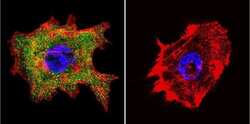
- Experimental details
- Immunofluorescent analysis of Cyclophilin D in A431 Cells. Cells were grown on chamber slides and fixed with formaldehyde prior to staining. Cells were probed without (control) or with a Cyclophilin D polyclonal antibody (Product # PA3-022) at a dilution of 1:200 overnight at 4 C, washed with PBS and incubated with a DyLight-488 conjugated secondary antibody (Product # 35552). Cyclophilin D staining (green), F-Actin staining with Phalloidin (red) and nuclei with DAPI (blue) is shown. Images were taken at 60X magnification.
- Submitted by
- Invitrogen Antibodies (provider)
- Main image
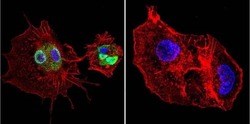
- Experimental details
- Immunofluorescent analysis of Cyclophilin D in HepG2 Cells. Cells were grown on chamber slides and fixed with formaldehyde prior to staining. Cells were probed without (control) or with a Cyclophilin D polyclonal antibody (Product # PA3-022) at a dilution of 1:200 overnight at 4 C, washed with PBS and incubated with a DyLight-488 conjugated secondary antibody (Product # 35552). Cyclophilin D staining (green), F-Actin staining with Phalloidin (red) and nuclei with DAPI (blue) is shown. Images were taken at 60X magnification.
- Submitted by
- Invitrogen Antibodies (provider)
- Main image
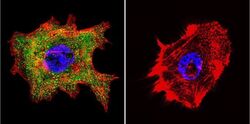
- Experimental details
- Immunofluorescent analysis of Cyclophilin D in A431 Cells. Cells were grown on chamber slides and fixed with formaldehyde prior to staining. Cells were probed without (control) or with a Cyclophilin D polyclonal antibody (Product # PA3-022) at a dilution of 1:200 overnight at 4 C, washed with PBS and incubated with a DyLight-488 conjugated secondary antibody (Product # 35552). Cyclophilin D staining (green), F-Actin staining with Phalloidin (red) and nuclei with DAPI (blue) is shown. Images were taken at 60X magnification.
- Submitted by
- Invitrogen Antibodies (provider)
- Main image
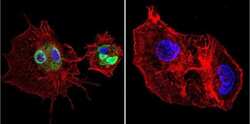
- Experimental details
- Immunofluorescent analysis of Cyclophilin D in HepG2 Cells. Cells were grown on chamber slides and fixed with formaldehyde prior to staining. Cells were probed without (control) or with a Cyclophilin D polyclonal antibody (Product # PA3-022) at a dilution of 1:200 overnight at 4 C, washed with PBS and incubated with a DyLight-488 conjugated secondary antibody (Product # 35552). Cyclophilin D staining (green), F-Actin staining with Phalloidin (red) and nuclei with DAPI (blue) is shown. Images were taken at 60X magnification.
Supportive validation
- Submitted by
- Invitrogen Antibodies (provider)
- Main image
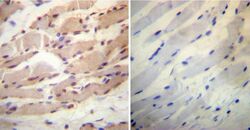
- Experimental details
- Immunohistochemistry was performed on normal deparaffinized human Skeletalmuscle tissue. To expose target proteins, heat induced antigen retrieval was performed using 10mM sodium citrate (pH6.0) buffer, microwaved for 8-15 minutes. Following antigen retrieval tissues were blocked in 3% BSA-PBS for 30 minutes at room temperature. Tissues were then probed at a dilution of 1:100 with a rabbit polyclonal antibody recognizing Cyclophilin D (Product # PA3-022) or without primary antibody (negative control) overnight at 4°C in a humidified chamber. Tissues were washed extensively with PBST and endogenous peroxidase activity was quenched with a peroxidase suppressor. Detection was performed using a biotin-conjugated secondary antibody and SA-HRP, followed by colorimetric detection using DAB. Tissues were counterstained with hematoxylin and prepped for mounting.
- Submitted by
- Invitrogen Antibodies (provider)
- Main image
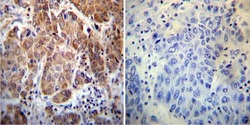
- Experimental details
- Immunohistochemistry was performed on cancer biopsies of deparaffinized human Hepatocarcinoma tissue. To expose target proteins, heat induced antigen retrieval was performed using 10mM sodium citrate (pH6.0) buffer, microwaved for 8-15 minutes. Following antigen retrieval tissues were blocked in 3% BSA-PBS for 30 minutes at room temperature. Tissues were then probed at a dilution of 1:200 with a rabbit polyclonal antibody recognizing Cyclophilin D (Product # PA3-022) or without primary antibody (negative control) overnight at 4°C in a humidified chamber. Tissues were washed extensively with PBST and endogenous peroxidase activity was quenched with a peroxidase suppressor. Detection was performed using a biotin-conjugated secondary antibody and SA-HRP, followed by colorimetric detection using DAB. Tissues were counterstained with hematoxylin and prepped for mounting.
Supportive validation
- Submitted by
- Invitrogen Antibodies (provider)
- Main image
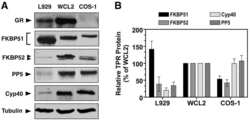
- Experimental details
- NULL
- Submitted by
- Invitrogen Antibodies (provider)
- Main image
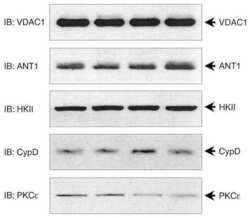
- Experimental details
- NULL
- Submitted by
- Invitrogen Antibodies (provider)
- Main image
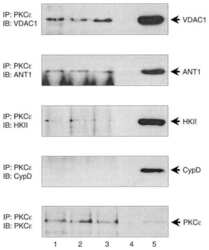
- Experimental details
- NULL
- Submitted by
- Invitrogen Antibodies (provider)
- Main image
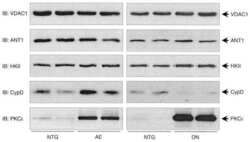
- Experimental details
- NULL
- Submitted by
- Invitrogen Antibodies (provider)
- Main image
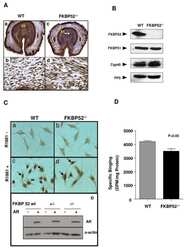
- Experimental details
- NULL
- Submitted by
- Invitrogen Antibodies (provider)
- Main image
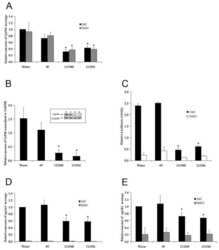
- Experimental details
- NULL
- Submitted by
- Invitrogen Antibodies (provider)
- Main image
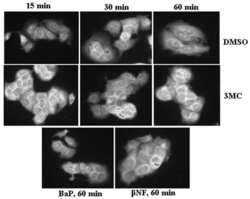
- Experimental details
- NULL
- Submitted by
- Invitrogen Antibodies (provider)
- Main image
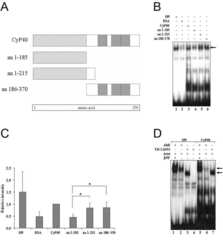
- Experimental details
- NULL
- Submitted by
- Invitrogen Antibodies (provider)
- Main image
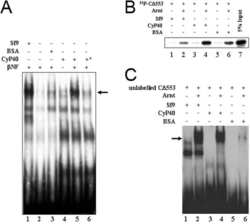
- Experimental details
- NULL
- Submitted by
- Invitrogen Antibodies (provider)
- Main image
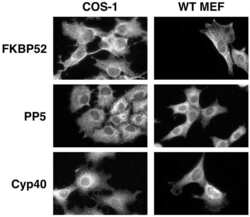
- Experimental details
- NULL
- Submitted by
- Invitrogen Antibodies (provider)
- Main image
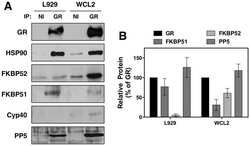
- Experimental details
- NULL
- Submitted by
- Invitrogen Antibodies (provider)
- Main image
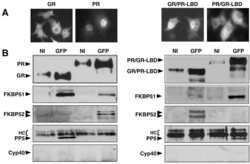
- Experimental details
- NULL
- Submitted by
- Invitrogen Antibodies (provider)
- Main image
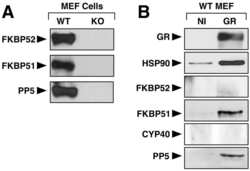
- Experimental details
- NULL
- Submitted by
- Invitrogen Antibodies (provider)
- Main image
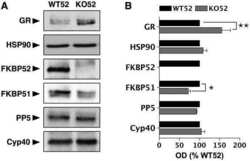
- Experimental details
- NULL
- Submitted by
- Invitrogen Antibodies (provider)
- Main image

- Experimental details
- NULL
- Submitted by
- Invitrogen Antibodies (provider)
- Main image
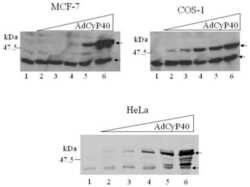
- Experimental details
- NULL
- Submitted by
- Invitrogen Antibodies (provider)
- Main image

- Experimental details
- NULL
- Submitted by
- Invitrogen Antibodies (provider)
- Main image
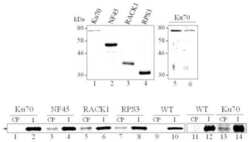
- Experimental details
- NULL
- Submitted by
- Invitrogen Antibodies (provider)
- Main image
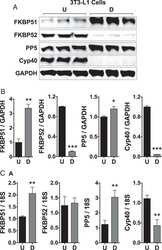
- Experimental details
- NULL
- Submitted by
- Invitrogen Antibodies (provider)
- Main image
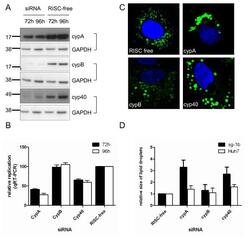
- Experimental details
- Figure 6 Enlarged lipid droplets correlate with inhibition of HCV replication using siRNA knockdown . A) sg-1b replicon cells were transiently transfected with siRNA to target cypA, cypB and cyp40. A RISC-free siRNA construct was used as a control. Whole cell lysates were analyzed for target protein expression by Western blot at 72h and 96h post-transfection. B) Total RNA from siRNA transfected cells was extracted and used for quantitative real-time RT-PCR to measure copies of HCV. Replication in RISC-free control cells was set to 100% for each time point. Results are the average of 4 independent experiments, +- standard deviation. CypA and cyp40 siRNA result in a statistically significant decrease in replicon activity, p < 0.01 for cypA and p < 0.05 for cyp40 compared to RISC-free siRNA by Students paired t-test. C) At 96h post-transfection, lipid droplets were visualized as described. Representative images for each siRNA are shown. D) 20X images were acquired and quantified by the Cellomics ArrayScan VTI HCS reader. The mean fluorescence intensities for BODIPY 493/503 were normalized to the RISC free siRNA control. Those siRNA constructs that resulted in inhibition of HCV [ 17 ] also caused the lipid droplets to become enlarged, similar to what is seen with NIM811 treatment.
- Submitted by
- Invitrogen Antibodies (provider)
- Main image
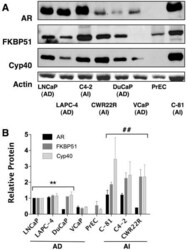
- Experimental details
- Figure 2 Over-expression of Cyp40, FKBP51 PCa cell lines. ( a ) WCEs from normal prostate epithelial cells (PrEC), androgen-dependent (AD) (LNCaP, LAPC-4, VCaP and DuCaP) and- independent (AI) (C4-2, C-81 and CWR22R) human PCa cell lines were prepared and analyzed by Western blot for expression of the AR, FKBP51, Cyp40 and actin, respectively, as described in Materials and Methods. ( b ) Densitometric scanning of the bands corresponding to protein expression of Cyp40, FKBP51 and the AR in PrEC, AD and AI human prostate cell lines. Cyp40, FKBP51 and AR protein levels were expressed as relative expression levels, taking the values obtained from LNCaP cells as 1. Results are representative of two independent experiments. AD vs PrEC, **P values ranged from
- Submitted by
- Invitrogen Antibodies (provider)
- Main image
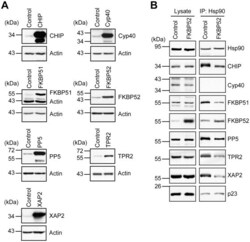
- Experimental details
- Figure 2 TPR proteins are significantly enhanced upon ectopic expression and change Hsp90 heterocomplex composition. A, SK-N-MC cells were transfected with plasmid expressing one of the TPR proteins, lysed after 48 h and levels of the respective TPR protein was determined by Western blot analysis. B, HEK-293 cells were transfected with FLAG tagged Hsp90 along with FKBP52 expressing plasmid or control plasmid. Hsp90 was precipitated from lysates and the levels of co-precipitated cofactors were determined by Western blot.
- Submitted by
- Invitrogen Antibodies (provider)
- Main image
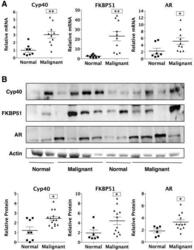
- Experimental details
- Figure 1 Over-expression of Cyp40 and FKBP51 in PCa specimens. ( a ) Total RNA was isolated from 8 normal and 10 malignant human prostate tissues, followed by real-time PCR using Cyp40-, FKBP51- and AR-specific primers and normalization to ribosomal 18S. RNA levels were expressed as relative to normal prostate tissue #1. *P
- Submitted by
- Invitrogen Antibodies (provider)
- Main image
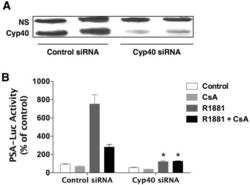
- Experimental details
- Figure 5 Down-regulation of Cyp40 inhibits AR activity. LNCaP cells were transiently transfected with Cyp40 siRNA or non-target control siRNA. Ninety-six hours later, the WCEs were prepared, and expression of Cyp40 was measured by Western blotting ( a ). LNCaP cells were transfected with Cyp40 siRNA or control siRNA, and the PSA-Luc reporter construct along with a beta-gal plasmid. Forty-eight hours later, cells were treated with or without R1881, CsA, CsA and R1881 for 24 h. Lysates were prepared and analyzed AR reporter gene activity ( b ). Results are means +- SEM of two independent experiments. *P
- Submitted by
- Invitrogen Antibodies (provider)
- Main image
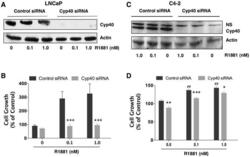
- Experimental details
- Figure 8 Down-regulation of Cyp40 predominantly inhibits androgen-dependent growth in PCa cells. AD LNCaP and AI C4-2 cells were transiently transfected with Cyp40-siRNA or control-siRNA. Six to 8 h after transfection, medium was changed. Twenty-four hours after transfection, cells were plated (1500 cells / well) in 96-well (cell proliferation assay) and 6-well plates (Western blotting). Seventy-two hours after transfection, LNCaP ( a ) and C4-2 ( c ) cells were treated with R1881 (0.1 and 1.0 nM) or vehiclel (0) for 24 h. Whole cell extracts were prepared, and expression of Cyp40 and actin (control) was measured by Western blotting. LNCaP ( b ) and C4-2 ( d ) cells were treated with R1881 (0.1 and 1.0 nM) or vehicle (0) alone for 3 days. Ninety-six hours after transfection, cell proliferation was determined by means of an MTT assay. Results are means +- SEM of two independent experiments, each performed in quadruplicate. LNCAP: pair-wise comparison of control siRNA vs Cyp40 siRNA at each condition, ***P
- Submitted by
- Invitrogen Antibodies (provider)
- Main image
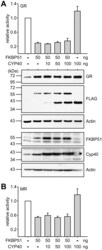
- Experimental details
- Figure 6 Cyp 40 is unable to compete the inhibitory effect of FKBP51. SK-N-MC cells were transfected with the MMTV-Luc reporter plasmid, the Gaussia-KDEL control plasmid, one of the plasmids expressing the HA-tagged GR or MR as indicated, and plasmids expressing FKBP51 and Cyp40 at the indicated amounts. After transfection, the cells were cultivated for 24 h in the presence of 10 nM cortisol (A) or 0.03 nM Fludrocortisol (B). Bar graphs indicate the relative reporter activity representing Firefly measurements normalized to Gaussia activities and presented as relative stimulation + S.E.M. of three independent experiments performed in triplicate. Lower panel of A displays immunoblots of cell extracts, probed with HA antibody demonstrating GR expression and the same membrane probed with FLAG antibody to detect overexpressed FKBP51 and Cyp40, and actin as control. In addition, antibodies directed against FKBP51 or Cyp40 were used to visualize the combined levels of endogenous and ectopic TPR protein.
 Explore
Explore Validate
Validate Learn
Learn